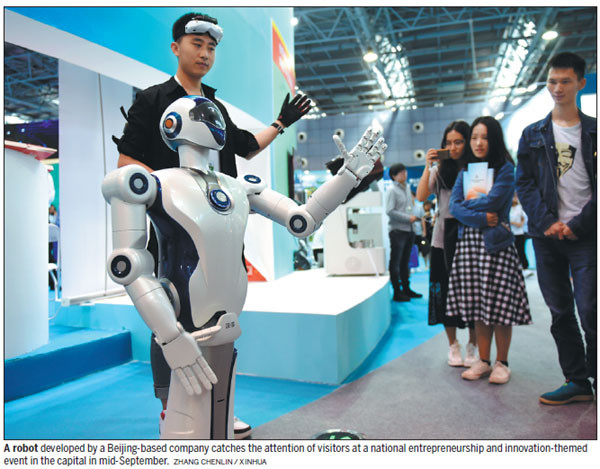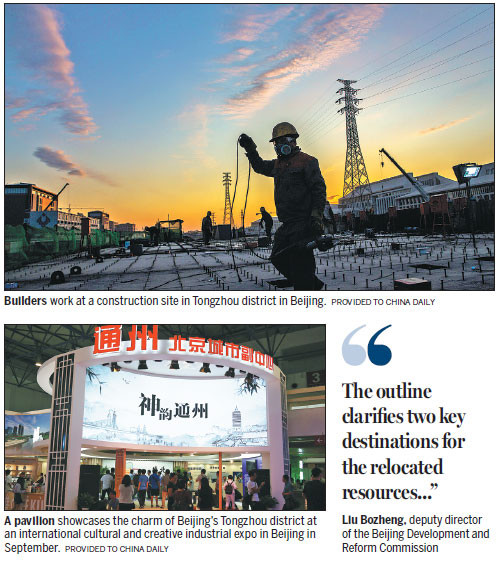Guide released for transfer of resources in Beijing, Tianjin and Hebei province China Daily
More and more industries and projects in Beijing have been relocated to Tianjin and Hebei province, in the wake of the integrated development of the three areas to create a regional economic powerhouse.
The accelerated push for integration comes three years after national leaders called for the coordination and integration of the economic zone surrounding Beijing in early 2014.
The planned super region embraces Beijing, Tianjin and part of Hebei province, a cluster inhabited by over 100 million people - three times the population Tokyo's megalopolis - and spanning an area of more than 200,000 square kilometers.
To guide the orderly transfer of resources, the Beijing-Tianjin-Hebei Integrated Development Office released an outline on Dec 20, providing details on how to redistribute the capital city's industrial resources.
"The outline clarifies two key destinations for the relocated resources - Tongzhou district in Beijing and Xiongan New Area in Hebei," said Liu Bozheng, deputy director of the Beijing Development and Reform Commission.
"The Caofeidian Integrated Development Zone in Hebei, the Beijing New Airport Economic Zone, the Tianjin Binhai New Area and the Zhangjiakou-Chengde Ecological Area in Hebei are the four key platforms to launch industrial cooperation projects," he noted.
To date, the Caofeidian zone has carried out 256 projects from Beijing and Tianjin. With a combined investment of 367.16 billion yuan ($55.97 billion), 129 of them are from Beijing.
Tianjin Binhai-Zhongguancun Science Park has attracted 316 companies since it was put into operation in November 2016.
The park integrates the innovation power of Zhongguancun, a technology hub in Beijing, to create an industrial cluster.
Construction on some key projects, such as the Baidu Binhai Innovation Center and the JD Binhai Cloud Space, launched by Chinese internet giants, has started in the park.
Bohai New Area Biopharmaceutical Industry Park has signed agreements with 102 pharmaceuticals companies, including 79 companies from Beijing and 13 from Tianjin.
In addition, the outline mapped out the creation of 46 professional industrial platforms: 15 for innovation, 20 for modern manufacturing, eight for services and three for agriculture.
The Beijing Development and Reform Commission's Liu said the government is also establishing a new system for creating policies on industrial redistribution and innovation.
The supportive policies in the areas of finance, land supply and environmental protection will be offered to help develop these regions in the future.
The coastal city of Tianjin will speed up the construction of industrial clusters and take over some of the capital's high-end projects from corporate headquarters, financial institutions and scientific research institutions.
That's according to Bai Xiangdong, director of a Tianjin branch of the Beijing-Tianjin-Hebei Integrated Development Office.
The city released a regulation to optimize the business environment for entrepreneurs on Nov 16. These included protection of property rights and initiatives in seven other fields.
Hebei is working closely with Beijing and Tianjin to build 55 scientific parks and 62 innovation centers, attracting 1,400 high-tech companies from the two cities.
Zhu Wenzhi, head of the Beijing-Tianjin-Hebei Integrated Development Office's Hebei branch, said that the province had signed agreements with 25,000 businessmen from Beijing and 10,150 have started operations in Hebei.
"We will continue to attract companies from high-tech industries, education, medical services, finance, research and design, and the cultural creative sector to Xiongan New Area and the surrounding regions," Zhu added.
caoyingying@chinadaily.com.cn

